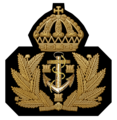Army/Air Force/Navy
| Captain Kapten | |
|---|---|
| Country | |
| Service branch | Army Air Force Navy (Amphibious Corps) |
| Abbreviation | Kn (Swedish), [2] Capt (English) [3] |
| Rank | Captain |
| NATO rank code | OF-2 |
| Non-NATO rank | O-3 |
| Next higher rank | Major |
| Next lower rank | Lieutenant |
| Equivalent ranks | Lieutenant (navy) Ryttmästare (cavalry) Förvaltare |
Kapten (captain) is a rank in the Swedish Army, Swedish Air Force and in the Swedish Navy (Coastal Artillery 1902–2000, Amphibious Corps 2000–present).
History
A kapten (captain) usually commanded an infantry company or an artillery battery. The name appeared quite early in the Middle Ages and then applied to the highest commander in an area, a city etc. With the standing armies, which began to be established in the latter half of the 15th century, it was the name of the commander of a unit in both the infantry and the cavalry, which unit was first called company, then fana and from the latter half of the 16th century company again, whose strength was then still far less than before. [4] The captains of the Swedish Coastal Artillery corresponded to the kapten (captain) of the army and kapten (lieutenant) of the navy. [5]
Duties
A captain in the army serves in three areas, as a commanding officer, as a staff officer and as an instruction officer, at skill levels B (Intermediate), C (Advanced) and D (Expert). Captain in the Amphibious Corps works as a commander, for example as platoon leader for advanced platoon or as deputy company commander and in exceptional cases company commander. In addition to the army requiring a completed tactical course Army (TakA) for a future captain, the focus is on creating an officer who is skilled in, for example, leading combat training with his own company (within the battalion) and competent to work as a company commander or staff officer. Common is that the individual should be able to work as a teacher in officer training. The requirement for service is at least two (2) years as a lieutenant. [6]
Promotion
According to Chapter 2, Section 1 of FFS 2018:7, a person who is eligible for promotion has served in the Swedish Armed Forces to such an extent that assessment of suitability, knowledge and skills could be carried out, is deemed suitable for promotion, possesses the knowledge and skills required for the higher rank, and meets time requirements according to Section 2 (must have held the rank for at least two years). [7] For promotion from lieutenant to captain, it is only required that the lieutenant is promotable according to Chapter 2, Section 1. For a lieutenant who has completed the Swedish Armed Forces' pilot training, promotion may only take place if the lieutenant has an academic degree at the undergraduate level. [8]
Promotion of captain to major may take place when the captain has completed applicable promotion training with approved results. After completing a tactical staff course at the Swedish Defence University, a captain who is OFSK may only be promoted to major with a passing grade if the position is within the functional area where the captain's special competence is located, and if the position's rank code is OF 3. Responsible head of promotion to captain is the unit commander. [9]
In the case of reserve officers, promotion of lieutenant to captain may take place if the lieutenant holds an academic degree at the undergraduate level, or at least 180 credits if the program includes more than 180 credits. Promotion of captain to major may take place when the captain has completed applicable promotion training with approved results. [8]
Rank insignia
Collar patches
- Collar patch m/58 for a captain
- Collar patch
Shoulder marks
Air Force
- (2003–present)
- (–2003)
Army
Navy (Amphibious Corps)
- Embroidered shoulder mark (Navy)
(2003–present) - Embroidered shoulder mark (Navy)
(–2003) - Woven shoulder mark (2003–present)
Sleeve insignias
Air Force
- Mess jacket sleeve insignia for a captain
- Flight suit sleeve insignia for a captain
(2003–present)
Army
- Sleeve insignia on uniform m/1906 for a captain.
Navy (Amphibious Corps)
- Sleeve insignia on innerkavaj m/48 ("inner jacket m/48") for a captain.
(2003–present) - Sleeve insignia on innerkavaj m/48 ("inner jacket m/48") for a captain.
(–2003)
Hats
- Hat (Mössa m/1923) for a captain
- Camp hat (Lägermössa m/1865-99) for a captain
- Hat (Mössa m/1865-99) for a captain in the Life Guards infantry
- Hat (Mössa m/1865-99) for a captain in the Life Regiment of Foot
- Hat (Mössa m/1865-99) for a captain in the Royal Engineers (Fortifikationen)
- Rank insignia for a captain on hat (Hatt m/1910-14) in the army
- Hat badge (Mössmärke m/1946) for a captain in the army
- Hat badge (Mössmärke m/1940) for a captain in the army
- Hat badge (Mössmärke m/1914) for a captain in the army on fur hat (pälsmössa m/1909-14)


























